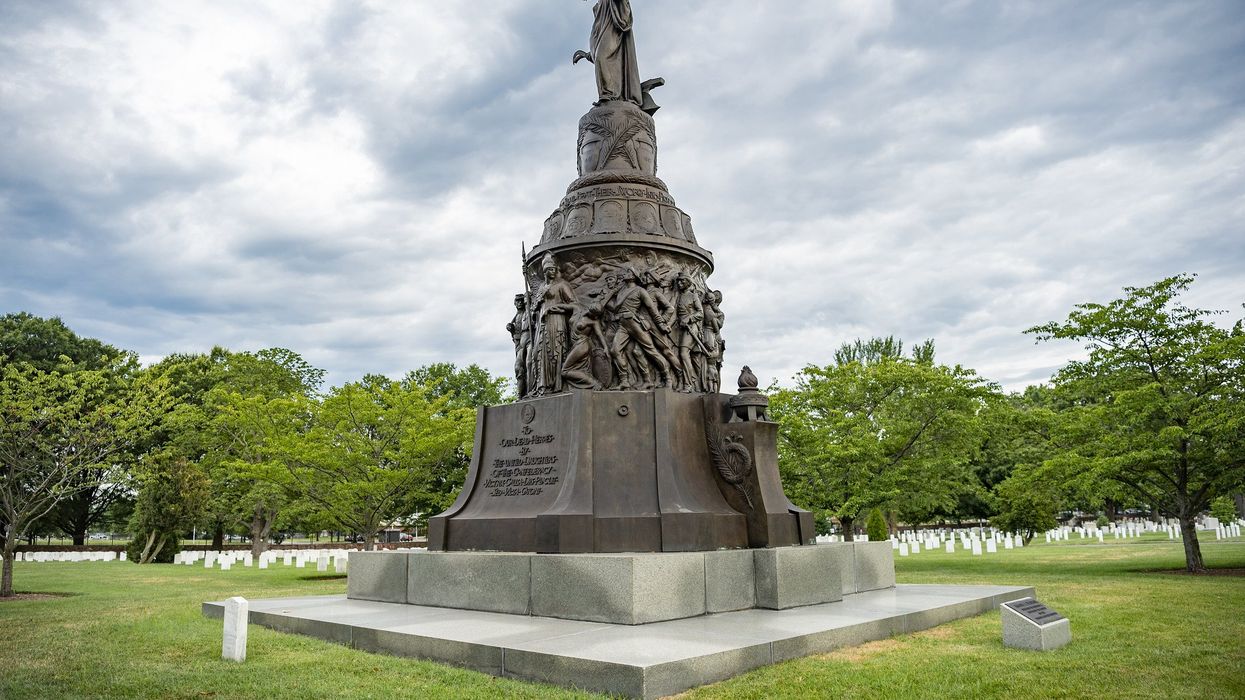
Arlingtn National Cemetery

Editor's note: Please see the most current article, "Judge halts toppling of Reconciliation Monument in Arlington National Cemetery," for updated information regarding these events.
The Department of Defense has dutifully taken part in an iconoclastic sweep of American history that has left graves dug up, statues toppled, animals renamed, busts melted down, and church windows removed.
Despite significant backlash, it appears no exception will ultimately be made for the Reconciliation Monument in Arlington National Cemetery. Workers will remove the 109-year-old monument this week, providing revisionists in the nation's capital with a gift of absence just in time for Christmas.
The Reconciliation Monument, also called the Confederate Memorial, was approved in 1906 by Secretary of War William Taft; commissioned by the United Daughters of the Confederacy in 1910; designed by Jewish former Confederate soldier Moses Jacob Ezekiel; and unveiled in Section 16 of the cemetery by President Woodrow Wilson on June 4, 1914.
The monument consists of a bronze female figure crowned with olive leaves atop a 32-foot pedestal. The female figure holds a laurel wreath, a pruning hook, and a plow. At her feet is a biblical inscription that reads, "They have beat their swords into plough-shares and their spears into pruning hooks."
Another inscription on the memorial states in Latin, "The victorious cause was pleasing to the gods, but the lost cause to Cato."
Thirty-two figures of mythical gods, Southern soldiers, and civilians are depicted around the base, including two black characters — one holding a baby and the other a slave following his owner to war. The memorial also displays 14 shields representing the 11 Confederate states and the border states of Maryland, Kentucky, and Missouri.
The memorial was intended as a monument to reconciliation in the aftermath of the Civil War.
Union army veteran President William McKinley, who supported legislation in 1900 to establish a Confederate section in Arlington Cemetery, proclaimed four days after men from former Confederate states ensured America's victory against Spanish forces, "In the spirit of fraternity we should share with you in the care of the graves of Confederate soldiers. … Sectional feeling no longer holds back the love we feel for each other. The old flag again waves over us in peace with new glories."
The American Conservative underscored that it was long understood to be a reconciliation monument, such that "some Confederate groups at the time opposed the statue and memorial precisely because they opposed the reconciliation that it symbolized. At the memorial’s dedication in 1914, President Wilson praised it as an 'emblem of a reunited people.'"
Arlington National Cemetery highlighted the monument's historic value, noting that it "offers an opportunity for visitors to reflect on the history and meanings of the Civil War, slavery, and the relationship between military service, citizenship and race in America. This memorial ... invites us to understand how politics and culture have historically shaped how Americans have buried and commemorated the dead."
The National Defense Authorization Act for fiscal year 2021, passed by a Democrat-controlled Congress, required the removal of "all names, symbols, displays, monuments, and paraphernalia that honor or commemorate the Confederate States of America (commonly referred to as the 'Confederacy') or any person who served voluntarily with the Confederate States of America from all assets of the Department of Defense."'
Congress established an eight-member commission in 2021 and tasked it with renaming military assets in accordance with this requirement. The deadline for such changes and removals is Jan. 1, 2024.
The commission addressed the Reconciliation Monument in its final report on Sept. 19, 2022, recommending that Arlington National Cemetery "remove the 32 life-sized bronze statues from the top of the monument but not remove the entire monument because doing so might damage graves under the structure."
Arlington National Cemetery indicated in March that it had begun preparations for the "careful removal and relocation" of the monument as required by Congress and demanded by Biden's Secretary of Defense Lloyd Austin.
There has been significant bipartisan outcry in the face of this particular iconoclastic initiative.
Former U.S. Sen. Jim Webb (D-Va.), cognizant that the memorial was built "with the sole purpose of healing the wounds of the Civil War," stressed in an August opinion piece in the Wall Street Journal that the statue's toppling would signify the desire of a "deteriorating society ... to erase the generosity of its past, in favor of bitterness and misunderstanding conjured by those who do not understand the history they seem bent on destroying."
Rep. Andrew Clyde (R-Ga.) was among over 40 Republicans who criticized the iconoclastic initiative, calling on Defense Secretary Austin in a Dec. 11 letter to suspend all removal activities related to the Reconciliation Monument until Congress finalized the appropriations process for fiscal year 2024.
Clyde noted that the memorial ought to be exempt from the removal requirement because it "does not honor nor commemorate the Confederacy; the memorial commemorates reconciliation and nation unity." Additionally, "the Naming Commission's authority explicitly prohibits the desecration of grave sites."
Arlington National Cemetery announced Saturday that the monument had been fenced off and would be removed by no later than Dec. 22. All but the granite pedestal will be taken away.
The cemetery further alleged that the removal is in compliance with both the National Environmental Policy Act and the National Historic Preservation Act, and that no nearby graves or headstones would be damaged during the "deconstruction" process.
"During the deconstruction, the area around the Memorial will be protected to ensure no impact to the surrounding landscape and grave markers and to ensure the safety of visitors in and around the vicinity of the deconstruction," the cemetery indicated in a statement.
Virginia Gov. Glenn Youngkin (R) plans to move the memorial to the New Market battlefield state historic park in Shenandoah Valley, reported the Military Times.
Like Blaze News? Bypass the censors, sign up for our newsletters, and get stories like this direct to your inbox. Sign up here!